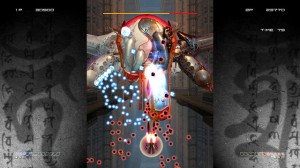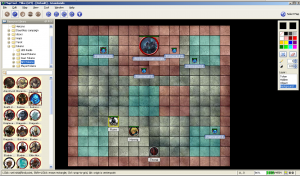Ah, Ikaruga, so much 4e content to mine for in one simple 5 stage bullet hell game.

For those not familiar with Ikaruga, it was a vertical shooter released for the Dreamcast back in 2001. It shared much with its shooter cousins, you were a spaceship, you shoot things, they try and shoot you down. You had to dodge their bullets, make to the boss, and have a battle before continuing onto the next stage, take a gander at this youtube video of gameplay, then come back and I’ll explain what you just saw.
Confused? Let me break it down. You can swap the polarity of your ship, switching between light and dark, and the whole game changes and is based on this theme. You absorb bullets of a like polarity and are killed by the opposite, and you deal more damage if your bullets are opposite the polarity of your target. Absorbing bullets builds a meter when full fires off a burst shot. And then there’s chaining, kill three like-colored enemies in a row, your chain goes up. High chains equal a higher score, so you can’t just hold the fire button down, you need to practice and time your shoots if you want the optimal score.
These simple twists switch take an otherwised well polished shooter game and make it something beyond exciting. You have to retrain your brain and your muscle memory, forgetting the ‘avoid all enemy bullets’ to ‘avoid some, hope to be hit by others, I need my homing lasers.’
Part of the frustrating joy of this game is you’re trying to balance your polarity, need for homing laser charge, need to shoot down enemies, keeping your combo going, and your position on the map all at the same time, all at a twitchy frantic speed. Slow it down, remove a lot of the twitch parts and it has the elements of things I like in good 4e encounters, choices. Do I switch to the dark to charge my weapon, even though doing so will mean I do less damage, or do I switch to light, increase my risk of being killed but increase my damage output. Or do I stay off to the side here, avoid all damage but greatly reduce my damage output.
These questions, making areas of play have different value one of the big things that make an encounter exciting. You can tank and spank in the center of the room, but if that’s all you’re doing players are only going to look at their power cards, not pay attention when it’s not their turn, and end up feeling like a grind even if it’s mechanically not. But I’ve found if something is happening across turns, or players and NPCs like have reason to move around a room, players tend to stay focused through the a fight, and make their turns faster when they receive initative.

Yeah, I know, adding complexity speeds things up, I’m a heretic, let’s look at this map I throw together in 10 minutes as an example. Party of three kick in the death knight’s room, having spent the past session figuring out his weakness. They know he can enchant the ground to weaken enemies and strengthen allies, but have found a way to switch those abilities around. This is the ‘polarity’ for the fight. Stand in a blue square, resist cold, vuln fire, all your damage have cold and only cold keyword, and just the opposite for red squares. Flameskulls are minions with a ranged single target attack, and the death knight brings out, 2d4+2 flameskulls as a free action on its turn.
Bloody or kill a foe, and you get to change the color of one tile. Spend a minor to make an arcana check, change the color of one tile. Death knight gets to change the color of the tile it places a flameskull minion on. And changing from one color tile to its opposite, either by forced or unforced movement, or having the tiles change out from under you damages the PCs only.
People are moving more often, or maybe focusing on taking care of minions based on their position in initative, trying to make a favorable position on the board and stay there, while the NPCs do what they can to counter. Maybe players will try to deactivate the square and force a page 42 check.
I’ll grant this might prove to be tough on a physical table, but on a virtual table top, creating transparent tiles and copying and pasting is easily done.
I know a lot of this isn’t ground breaking, the concept of risk/reward tiles is pretty well known, and that’s what this Ikaruga-esque encounter is built on. However, this is also just a setup. Ikaruga is a game just barely in the sub-genre of what’s called bullet hell shooters; imagine the screen covered in 95% bullets and you have to dodge. Them. All. It’s the epitimy of twitch gaming, with most bullet hells often rating 2000 or 3000 milliBattletoads in game frustration.
And my next post will be bringing these type of shooter games to your 4e table. Hint, it involves lots and lots of minions. Until then, what are some of the tricks you use or have been used on to you keep your 4e combats fluid and moving?

I love this concept!
I was already planning an encounter with moving platforms triggerable by both players and NPCs, the idea was that some platforms might shove people into traps, grant them cover, etc.
My idea was that with some planning the players might shepherd ranged enemies into a “killbox” where they couldn’t escape the opportunity attacks of the melee fighters. And of course, vice-versa.
But with your polarity idea i might deepen this concept a little further :)
Allowing my fire-happy Wizard to maneuver himself onto a platform that grants him further fire damage would surely make his day, until he’s hit with a Frostbeam that is ;)